I woke up today with excitement in my heart, ready to explore one of the most beautiful and challenging parts of my Pakistan tour: the Baboon Valley. My plan was simple, at least on paper—leave early, ride from Kutton, and make my way into the wilderness. But the universe had other plans. When I woke up at 6 am, the rain was pouring cats and dogs. I peered through the tent window and watched the river beside the resort swell slightly from the early morning rainfall. The skies were grey, heavy, and moody, as if testing my determination.
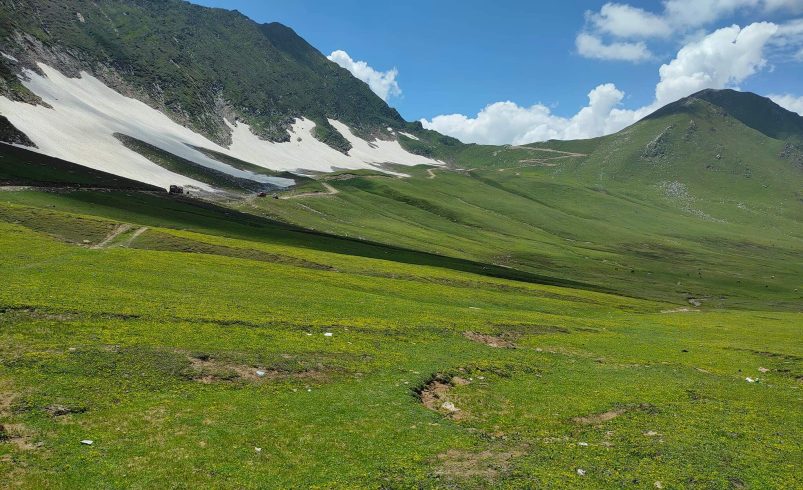
I had already packed a small bag with all my camera gear, leaving my heavier luggage at the hotel. This decision was crucial; carrying less weight meant more control over my motorcycle on rough terrain. Still, the mess was closed, and no one was at the reception to look after my luggage. I knew I would have to wait until at least 8 am to start my breakfast and officially set off.
Waiting in this paradise, however, was not a punishment. The first rays of dawn filtered through clouds, casting a soft light on the Jagran Stream flowing beside the village. I couldn’t resist; I took out my drone and captured some shots of the landscape. Even in the rain, the valley looked ethereal, its forests and mountains shrouded in mist.
Finally, the reception opened. I left my luggage safely and said a prayer before starting this leg of the journey. My excitement was tinged with nervousness; I had heard that this off-road trek was no ordinary ride.
As I left the village of Kutton, the sound of the Jagran Stream beside me was calming, though I knew it was only the beginning. The traffic was surprisingly dense for this early hour; most tourists were from Karachi, coming to enjoy the serene beauty of the valley. The paved road soon ended, giving way to gravel, mud, and uneven terrain. I stopped to ask locals about the distance to Baboon Valley. “It’s quite far, sir… about three hours off-road,” one of them replied.
From here, the real adventure began. The asphalt patches ended, replaced by bare earth and loose stones. The motorcycle made a new, fluttering sound, and I realized my backpack was about to fall. I quickly adjusted it. The bag contained all my cameras—any mishap would be disastrous. A moment of panic passed, and I secured it again, double-checking every strap.
The route to Baboon Valley was unforgiving. A narrow suspension bridge appeared in front of me, spanning a small stream that had swollen from the rain. I paused, heart racing. “Is it safe for my motorcycle?” I asked a local guide. “Yes, go confidently,” he replied. I took a deep breath, said Bismillah, and carefully crossed. My pulse was high, but the thrill of the adventure outweighed my fear.
As I progressed, the path became increasingly treacherous. Loose rocks shifted beneath the tires, and the soil was wet from overnight rain. It became clear that this part of the journey required more than just courage—it required skill, patience, and respect for the terrain. I saw jeep tracks beside the stream; clearly, 4×4 vehicles had an easier time, but motorcycles demanded constant vigilance.
About halfway through, I realized the Baboon Valley trek was beyond my current capabilities. It wasn’t just the motorcycle; the path itself was a maze of bare rocks, with no defined trail. Even if I reached the end, the constant tension and danger would overshadow the enjoyment. Reluctantly, I decided to turn back. It was a tough choice—I had come all this way—but survival and common sense came first.

Returning to Kutton was a relief. The village welcomed me back with the calm beauty that had first drawn me here. My luggage was ready, and I prepared for the next adventure: Ratti Gali Lake.
Table of Contents
ToggleThe Journey to Ratti Gali Lake
After a quick meal at Duwariyan—chickpea rice with curry—I packed my luggage onto a jeep and kept only my tank bag with me for the trek ahead. This leg of the journey promised challenges but also beauty far beyond imagination. The first 7 km were manageable, paved and relatively smooth, but the last 11 km would be entirely off-road. My guide, Shafiq, assured me that if I faced difficulty, he would assist, and the jeep would provide backup.
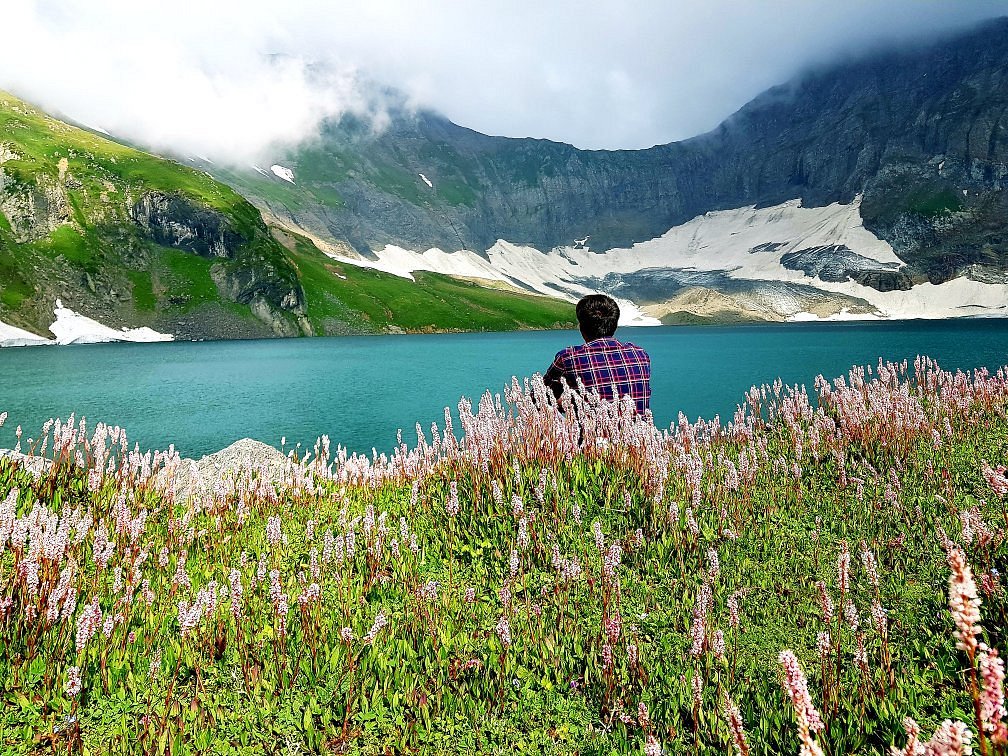
As I rode, the Neelum River accompanied me, its waters clear and cold, rushing through the valley with a relentless energy. The surrounding mountains rose steeply, forests clinging to their slopes. Occasional landslides and fallen rocks reminded me of the raw, untamed nature of this region. My motorcycle bounced over uneven terrain, tires gripping the wet stones as I carefully navigated each patch.
The final section before base camp was pure adventure. Rocks littered the track, sometimes loose, sometimes wedged in the soil, forming a treacherous mosaic. At one point, the jeep stopped to let me ride ahead, ensuring that if I encountered difficulty, help was close behind. The adrenaline surged, every twist and turn demanding full concentration. I stopped briefly, captivated by the sheer beauty around me. The mountain peaks, the dense pine forests, and the rushing streams combined into a symphony of nature that no photograph could truly capture.
Finally, I reached the base camp of Ratti Gali Lake. A sense of achievement washed over me—I had overcome the roughest terrain, navigated treacherous paths, and now stood at the threshold of one of Pakistan’s most beautiful alpine lakes. The jeep would carry my luggage further, allowing me to hike lightly toward the lake itself.
Camping at Ratti Gali Lake
Permission to camp by the lake had been granted after some negotiation with local authorities. Setting up the tent, I was immediately struck by the silence and serenity of the place. Unlike the crowded trails near Kutton, here I had solitude. The lake shimmered under the muted sunlight, partially obscured by lingering clouds from the morning rain. The water reflected the surrounding mountains like a perfect mirror.
The night was cold—near zero degrees—but my sleeping bag kept me warm. I woke up around 5 am, greeted by the soft patter of rain and the gentle hum of the lake. The delay gave me a chance to savor the moment. By 6:30 am, the clouds started to part slightly, revealing the emerald green of the forests and the crystalline blue of the lake. Breakfast was simple: cereal and coffee, but it tasted extraordinary here, amid such grandeur.
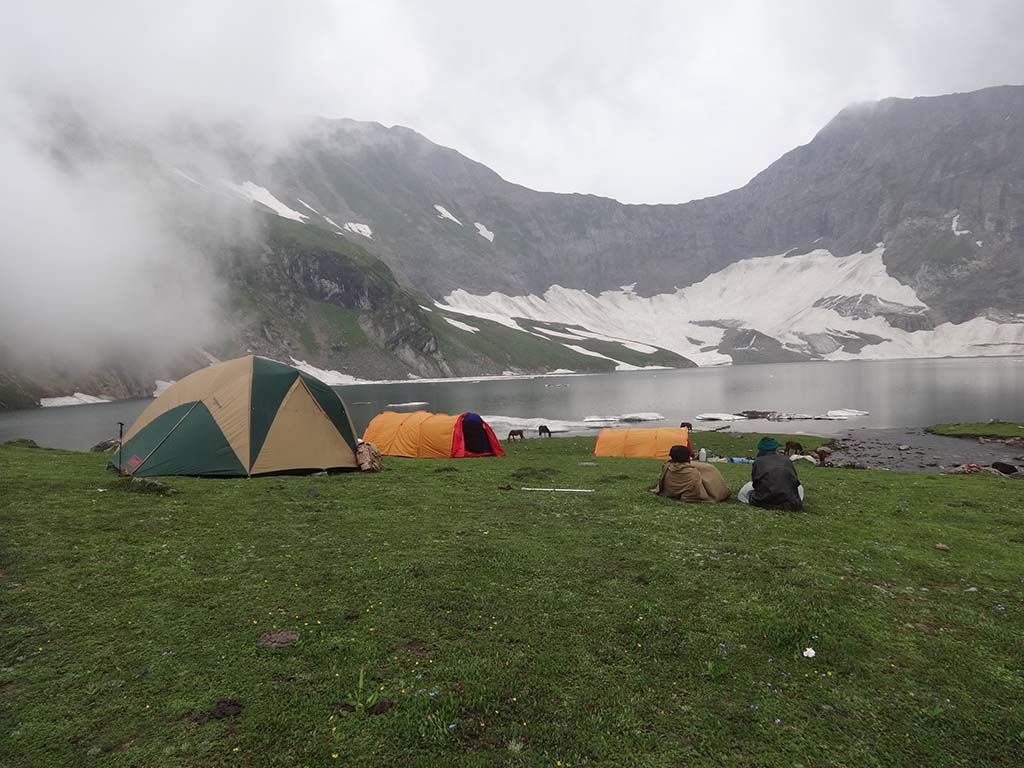
I took drone shots, capturing the entire valley from above. The lake looked even more majestic from this perspective, its clear waters glinting like liquid sapphire amidst the rugged mountains. The experience was humbling—nature, in its rawest form, had left me awestruck.
Reaching the base camp of Ratti Gali Lake felt like stepping into another world. The last stretch of off-road had tested every bit of my skill, patience, and courage, but now I was rewarded with a place so serene it almost felt unreal. The lake itself, nestled high in the mountains, shimmered beneath the muted morning light, partially hidden by the lingering clouds from overnight rain. Its waters were an astonishing shade of turquoise, reflecting the surrounding pine forests and snow-capped peaks like a flawless mirror.
Setting up my tent was the first priority. I wanted a safe, flat spot that wasn’t too close to the water but still offered a stunning view. Thankfully, the ground was firm despite the recent rain, and I managed to pitch the tent securely. My sleeping bag, rated for 0°C, promised to keep me warm through the cold night ahead. Even so, I could feel the chill creeping in as the wind swept down the valley.
With the tent ready, I allowed myself a few moments to just stand there, taking in the silence. It was profound—no sounds of traffic, no buzzing crowds, only the soft rush of water from the lake’s inlet and the occasional rustle of pine trees in the wind. It was a stark contrast to the rough, chaotic terrain I had navigated just hours earlier.
Breakfast was a simple affair: cereal and coffee, but in this environment, it tasted extraordinary. Sitting on a small rock beside the tent, sipping warm coffee, I could see my breath mingling with the cool mountain air. The clouds were slowly dispersing, revealing the lake in its full glory. Drone shots captured its expansive beauty, with the mountains forming a natural amphitheater around it. Each frame seemed more breathtaking than the last.
I spent the day exploring the immediate surroundings, taking short hikes along the lake’s edge. The water was crystal clear; I could see rocks and pebbles at the bottom, untouched and pristine. The air smelled of wet pine, fresh earth, and the faint scent of the river. I reminded myself to be careful not to leave any litter behind—the beauty of this place demanded respect.
As evening approached, the sun’s rays broke through the clouds in golden shafts, illuminating the lake and mountains in a magical light. It was perfect for photography, but even more perfect for simply sitting quietly, absorbing the moment. I had the entire lake to myself—no other tourists, no distractions—just the raw, majestic beauty of nature.
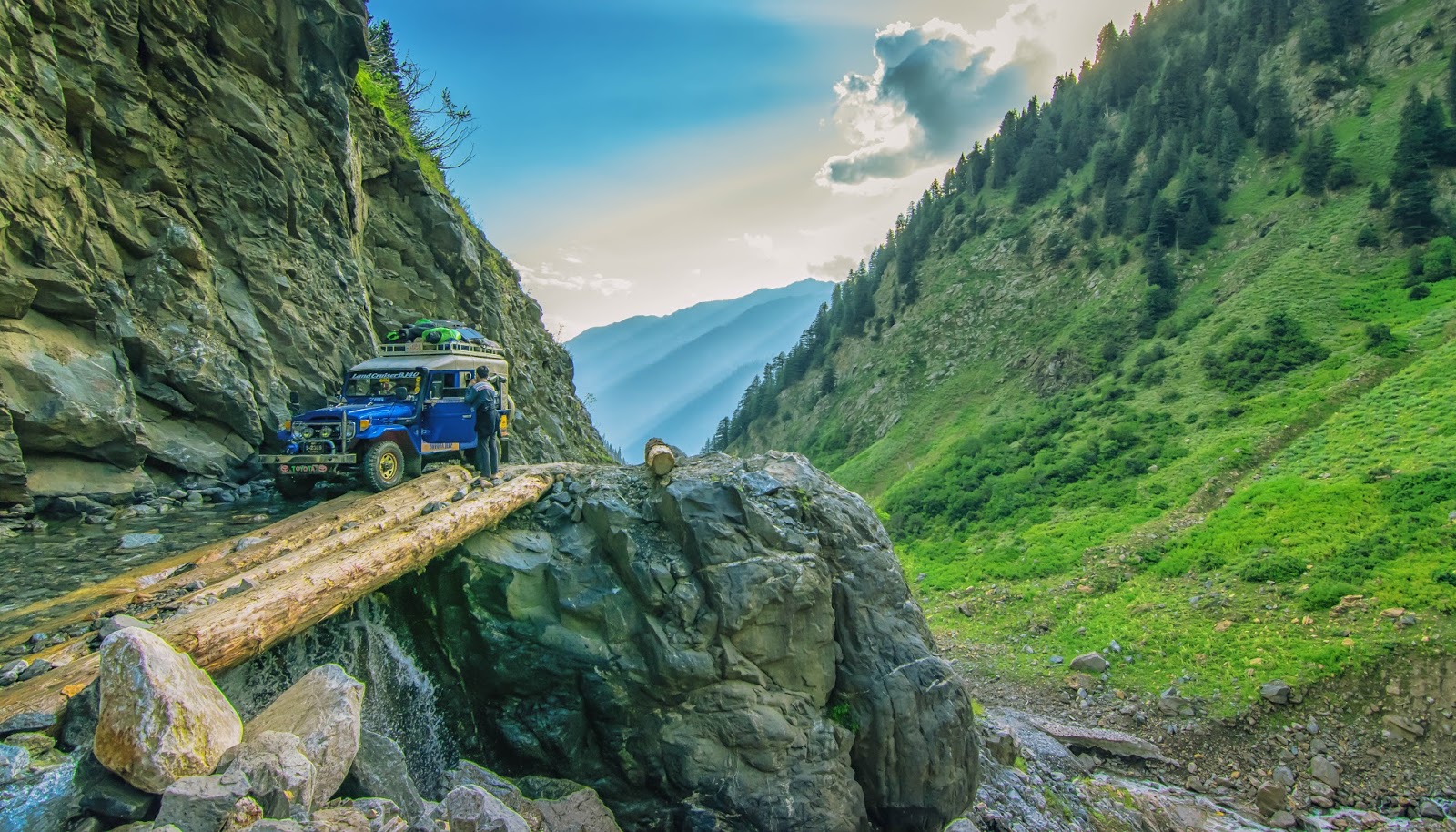
Nightfall brought a deep, profound silence. The temperature dropped sharply, but my sleeping bag kept me warm. Lying inside, I could hear the distant rush of water and the occasional hoot of an owl. The sky cleared, revealing a blanket of stars unlike anything I had ever seen. The Milky Way stretched across the horizon, mirrored faintly in the lake’s surface. It was humbling, almost spiritual.
Before sleeping, I took a final look outside the tent. The lake glowed faintly under the moonlight, and the mountains stood like silent guardians. I felt a deep sense of peace and accomplishment—after the long, challenging ride, the tough off-road trek, and the uncertainty of the day, I was here, alone with nature at its most magnificent.
Camping at Ratti Gali Lake wasn’t just an overnight stay—it was an experience of solitude, reflection, and connection with the raw power and beauty of the northern mountains of Pakistan. It was a reminder that sometimes the journey is just as important as the destination, and that the challenges faced along the way only make moments like these more extraordinary.
Lessons from the Journey
This expedition was more than a travel experience; it was a journey of patience, courage, and humility. Baboon Valley taught me the importance of knowing one’s limits. Ratti Gali reminded me that perseverance and preparation could lead to unimaginable rewards. Along the way, I interacted with locals, navigated off-road challenges, and captured some of the most breathtaking landscapes I have ever witnessed.
The motorcycle journey, with its highs and lows, was symbolic of travel itself: unpredictable, sometimes frightening, but ultimately deeply rewarding. The kindness of the locals, the beauty of the Neelum Valley, and the sheer thrill of adventure made every challenge worthwhile.
Final Reflections
As I packed up my gear to leave Ratti Gali Lake, I felt a sense of deep gratitude. Nature, in all its untamed glory, had tested me, rewarded me, and left me inspired. The mountains, rivers, and forests of Neelum Valley are not just sights to see—they are experiences to be felt with every sense.
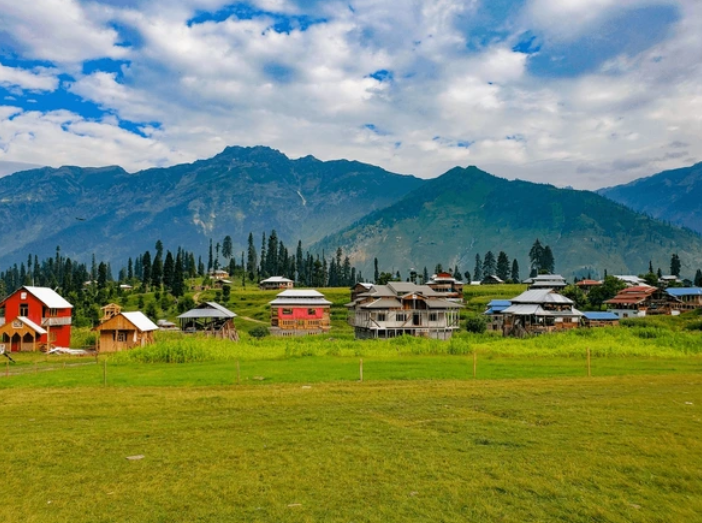
I hope that anyone reading or watching this journey can feel even a fraction of the awe and excitement I felt. Respect for nature, preparation, and a willingness to embrace challenges are the keys to truly experiencing the beauty of Pakistan’s northern regions.
Until the next adventure, I carry these memories in my heart, ready to share the stories and lessons of the mountains, rivers, and valleys with everyone.








